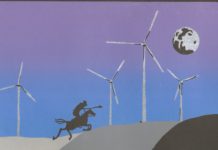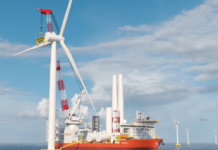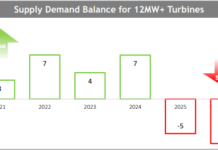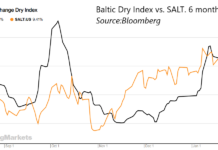Tom Konrad CFA
The Growth of Offshore Wind
Offshore wind has finally gotten a toe hold in the United States.
The United States’ first offshore wind farm, the 30 megawatt (MW) Block Island Wind Farm, is under construction. A new project, the South Fork Wind Farm will be three times the size of Block Island (90 MW), is set to be approved by the Long Island Power Authority. This project will be located 30 miles East of Montauk, NY and Southeast of Block Island in a wind energy area designated by the federal Bureau of Ocean Energy Management (BOEM.)
BOEM also recently designated 81,130 acres of outer continental shelf off New York’s Long Island and New Jersey as a new commercial wind energy area. This area’s proximity to some of the nations’ most expensive and capacity constrained parts of the nations’ electric grid make it an excellent site for relatively expensive but abundant offshore wind energy.
Both are projects of Deepwater Wind, the country’s leading offshore wind developer.
Offshore Wind Stocks: Over The Horizon
Investors looking for a way to invest in offshore wind will be disappointed to note that Deepwater Wind is principally owned by the D.E. Shaw group, a privately held partnership. The best investment opportunities in offshore wind stocks are, like offshore wind itself, often located beyond the horizon.
One place to look for stock market investments are the suppliers to wind farms. Offshore wind turbine suppliers are a natural first choice.
GE (NYSE: GE) is supplying the turbines for Block Island Wind. Again, this will be a little disappointing to stock market investors. While GE is a publicly traded company, offshore wind turbines are not a significant part of its business. The company’s Renewable Energy segment accounts for less than 20% of total revenue, and offshore wind is a tiny fraction of that.
Offshore wind turbines tend to be larger and more rugged than their onshore counter parts. The large size is due to the expense of foundations, making it important for an offshore farm to generate as much power as possible from each turbine. A typical onshore wind farm uses turbines with peak power output of around 2 MW each. Block Island is using just five 6 MW turbines.
These large sizes make it difficult for new entrants to challenge established manufacturers. This means that offshore wind manufacturers a very elite bunch. This is good for offshore wind investors because it means that industry incumbents (which are often public) are likely to remain leaders for far into the future. But it is bad for investors looking for a pure-play exposure to offshore wind. Offshore wind turbine manufactures simply do not exist without a large onshore wind business to support the investment in manufacturing and R&D.
Most wind turbine manufacturers serve both the onshore and offshore market, but the ones with the biggest names in offshore wind are European players Siemens AG (OTC:SIEGY) and Vestas (OTC: VWDRY).
It’s not particularly surprising that European manufacturers lead the offshore wind turbine market, since Europe has long been the leading offshore wind market. Because offshore wind sites are almost by definition accessible by ship, I expect that the early dominance of European offshore wind manufacturers will prove to be more durable than the early dominance of European solar manufacturers proved to be in the early 2000s.
Wires
Another way offshore wind is different from its onshore cousin is the need for underwater electrical connection to shore. Again, investors will not find pure-play offshore wind companies, but underwater cables need to be strong and durable enough to survive decades under salt water and the occasional encounter with a ship’s anchor or other submarine hazard.
Submarine cables are expected to be the fastest growing segment for electrical cable manufacturers over the next five years. US-Based General Cable (NYSE:BGC) and European Prysmian S.P.A. (OTC:PRYMF) both have large submarine cable businesses.
Owners and Developers
No article on offshore wind stocks would be complete without a mention of Danish energy giant Dong Energy A/S (Copenhagen:DENERG.) Dong is a diversified energy developer and utility with a focus on sustainable energy. The company has long pioneered new offshore wind technology, and is a leading European developer.
Foundations
Much of the investment in offshore wind is under the surface of the water, in the foundations. Constructing these giant, incredibly strong structures under windy seas is also a technical feat requiring specialized equipment. Holland’s Sif Group (Amsterdam: SIFG) is the leader in this market, where it gets approximately two-thirds of its revenue. This makes Sif the closest thing to a pure-play offshore wind company available. The balance of its revenue comes from foundations for oil and gas.
Conclusion
Offshore wind is a rapidly growing and exciting form of renewable energy, and the established industry leaders have wide moats protecting them from startup competition. This combination means that current leaders are likely to continue to lead, but it also means that pure offshore wind exposure is difficult, if not impossible to find. The only stock that is more offshore wind than anything else is Sif Group, and that company’s exposure to oil and gas may be too much for some investors excited about renewable energy.
This article was first published on GreenTech Media on July 19th.
Disclosure: Tom Konrad manages and invests in The Green Global equity Income Portfolio, which owns BGC.
DISCLAIMER: Past performance is not a guarantee or a reliable indicator of future results. This article contains the current opinions of the author and such opinions are subject to change without notice. This article has been distributed for informational purposes only. Forecasts, estimates, and certain information contained herein should not be considered as investment advice or a recommendation of any particular security, strategy or investment product. Information contained herein has been obtained from sources believed to be reliable, but not guaranteed.








Good insight. A point that should be made regarding offshore wind is that, at least in Europe, the only reason it is profitable is because of the renewable energy certificates. Another, much larger, issue with offshore wind is that the technology for large turbines (such as 5 MW machines) is really pretty new and there have been a lot of premature machine failures. Right now in Europe it seems like companies are grabbing offshore locations so that they will be able to make profits when they re-power the sites because margins are incredibly thin in the current situation.
Offshore wind is indeed expensive, but in places like NYC and Long Island (with the highest power prices in the country) there are few other options for obtaining bulk renewable power because of a constrained grid. New York State just passed a 50% renewable portfolio standard, to be achieved by 2030. You do the math.